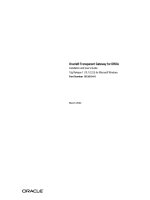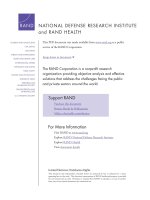The Shipbuilding and Force Structure Analysis Tool - A User’s Guide ppt
Bạn đang xem bản rút gọn của tài liệu. Xem và tải ngay bản đầy đủ của tài liệu tại đây (3.27 MB, 166 trang )
THE SHIPBUILDING
&
FORCE STRUCTURE ANALYSIS TOOL
A USER’S GUIDE
Prepared for the
U.S. Navy
Approved for Public Release;
Distribution Unlimited
R
NATIONAL DEFENSE RESEARCH INSTITUTE
Mark V. Arena • John F. Schank • Megan Abbott
The research described in this report was sponsored by the U.S.
Navy. The research was conducted in the RAND National Defense
Research Institute, a federally funded research and development
center supported by the Office of the Secretay of Defense, the Joint
Staff, the unified commands, and the defense agencies under
Contract DASW01-01-C-0004.
The RAND Corporation is a nonprofit research organization
providing objective analysis and effective solutions that address the
challenges facing the public and private sectors around the world.
RAND’s publications do not necessarily reflect the opinions or
policies of its research sponsors.
© Copyright 2004 RAND
All rights reserved. No part of this book may be reproduced in any
form by any electronic or mechanical means (including
photocopying, recording, or information storage and retrieval)
without permission in writing from RAND.
Published 2004 by RAND
1700 Main Street, P.O. Box 2138, Santa Monica, CA 90407-2138
1200 South Hayes Street, Arlington, VA 22202-5050
201 North Craig Street, Suite 202, Pittsburgh, PA 15213-1516
RAND URL: />To order RAND documents or to obtain additional information,
contact Distribution Services: Telephone: (310) 451-7002;
Fax: (310) 451-6915; Email:
Library of Congress Cataloging-in-Publication Data
Arena, Mark V.
Shipbuilding and force structure analysis tool : a user’s guide / Mark V. Arena,
John F. Schank, Megan Abbott.
p. cm.
Includes bibliographical references.
“MR-1743.”
ISBN 0-8330-3484-7 (pbk. : alk. paper)
1. United States. Navy—Procurement—Mathematical models. 2. Warships—
United States—Design and construction—Mathematical models. 3. Shipbuilding
industry—United States—Mathematical models. 4. Military planning—United
States—Mathematical models. I. Schank, John F. (John Frederic), 1946– II.
Abbott, Megan E., 1971– III.Title.
VC263.A798 2003
359.6'84'028557565—dc22
2003019132
Cover design by Stephen Bloodsworth
iii
PREFACE
Periodic defense reviews require analysts to address difficult
questions regarding the Navy’s ship force structure, resource levels
and allocations, and the shipbuilding industrial base. While a range
of tools is available to assist analysts in their decisionmaking, the
need for improvement exists. In earlier research, RAND identified the
types of issues that arise during major defense reviews and described
the abilities of the tools currently available to address those issues.
RAND also described an overarching analytical architecture that
could assist the Office of the Secretary of Defense (OSD), Navy, and
other organizations in addressing the difficult naval ship–related
questions.
This document describes the effort to implement the integrated
architecture as outlined in the earlier work. Also contained in this
document are detailed user instructions (see the Appendices) for
those interested in exercising the analytical capability of the tool.
The Assessments Division of the Deputy Chief of Naval Operations
for Resources, Warfare Requirements, and Assessment (OPNAV/N81)
sponsored this portion of the research. The research should be of
interest to OSD and Navy policymakers, planners, and analysts
concerned with shipbuilding resource requirements and industrial
base.
This research was conducted for the U.S. Navy within the Acquisition
and Technology Policy Center of RAND’s National Defense Research
Institute, a federally funded research and development center
sponsored by the Office of the Secretary of Defense, the Joint Staff,
the unified commands, and the defense agencies.
v
CONTENTS
Preface iii
Figures ix
Tables xiii
Summary xv
Acknowledgments xix
Acronyms xxi
Chapter One
INTRODUCTION 1
Background 1
Past Studies: Methods and Their Limitations 3
A New Model: Learning from Past Limitations 5
Shipbuilding and Force Structure Analysis Tool 6
Chapter Two
AN OVERVIEW OF THE ANALYSIS TOOL 9
Fundamentals of the Tool’s Architecture 9
Key Concepts of the Tool 13
Stored Data and Data Sets 13
Main Inputs 14
Main Outputs 15
Force Transition Model: An Overview 17
How the Model Generates a Shipbuilding Plan 17
The Industrial Base Model: An Overview 21
The O&S Cost Model: An Overview 22
vi The Shipbuilding and Force Structure Analysis Tool: A User’s Guide
The Financial Adjustments and Assumptions Model:
An Overview 22
Constant-Dollar Basis and Net Present Value 23
Assumptions Check 25
Chapter Three
THE INDUSTRIAL BASE MODEL 27
Shipyard Production Labor 27
The Labor Metric: Full-Time Equivalent 28
Ship Class Labor 29
First-of-a-Class Versus Follow-on Ships 29
Workload, Labor Profiles, and Learning 31
The “Project” Concept: When Labor Is Divided Across
Shipyards 32
Contractor Roles 33
Shipyard Labor and Costs 35
New Production, Existing Production, and
Other Work 35
Effective Versus Required Labor 36
Attrition, Hiring, and Termination Rates 37
Productivity 38
Burden Costs 39
The Industrial Base Model in Action 40
Required Labor Calculations 41
Effective Labor Calculations 42
Productivity Calculations 43
Chapter Four
WORKING WITH THE TOOL 47
Summary 47
Running the Models 49
Limitations of the Tool 49
Data Updates Required 49
Force Transition Model Limitations 51
Industrial Base Model Limitations 51
Dealing with Real-World Problems 52
Implications of Changing Ship Life 52
Detecting Industrial Base Problems 54
Extending or Moving Construction Time for a Ship 54
Changing Force Structure 55
Conclusion 56
Contents vii
Appendix
A. MICROSOFT ACCESS AND TOOL INSTALLATION 59
B. START-UP AND CREATING A DATA SET 67
C. DATA EDIT AND ENTRY 73
D. RUNNING THE DATA SET—CALCULATIONS 111
E. GENERATING REPORTS 119
F. COMPARISON UTILITY 133
G. SHIP ROLES, HULL TYPES, AND CLASSES 141
References 143
ix
FIGURES
S.1. Summary Tool Architecture xvi
2.1. High-Level Architecture 10
2.2. Model Inputs and Outputs 14
2.3. Flow Diagram for Force Transition Model 18
2.4. Example Acquisition Plan 21
3.1. First-of-a-Class Versus Follow-on Ship Workloads 30
3.2. Example Labor Profile 32
3.3. Example Production Plan 34
3.4. Flow Diagram for the Industrial Base Model 41
4.1. Edit Ship Class Data 53
A.1. Needed References for VBA 63
A.2. Entering the Solver DLL Key String in VBA Editor 65
B.1. Warning Screen 68
B.2. Top-Level Menu 69
B.3. Manage Data Sets Form 70
B.4. A Selected Data Set 70
B.5. Successful Link to a New Data Set 71
C.1. Data Edit and Entry Menu 73
C.2. Example of Active Status Bar 75
C.3. Edit Active Fleet Information Form 76
C.4. Force Level Requirements 77
C.5. Ships in Production Data Entry Form 78
C.6. Example Acquisition Plan 80
C.7. Modify Acquisition Table Format 81
C.8. Edit New Production Plan 83
C.9. Edit Other Work List 84
C.10. Edit Ship Class Data Form 86
C.11. Learning Data Subform 89
x The Shipbuilding and Force Structure Analysis Tool: A User’s Guide
C.12. Material and Equipment Subform 91
C.13. Operations and Support Costs Subform 93
C.14. Labor Subform 94
C.15. Funding Profile Subform 96
C.16. Edit Hull Types 97
C.17. Edit Ship Roles 98
C.18. Shipyard Labor Data 99
C.19. Shipyard Burden Rates 102
C.20. Productivity Data 103
C.21. Other Work Material and Equipment Subform 105
C.22. Other Work Labor Data Subform 106
C.23. Edit Labor Profile 107
C.24. Edit Inflation Index Data 109
C.25. Data Source Documentation Form 110
D.1. Calculations Form 111
D.2. Select Calculation Method 112
D.3. Missing Production Data Warning 114
D.4. Funding Assumptions Form 115
D.5. Invalid Funding Data Warning 117
E.1. Reports Menu 119
E.2. Labor Output Form 121
E.3. Required Labor (FTE) at a Shipyard by Class 122
E.4. Required Labor (FTE) by Class as a Table 123
E.5. Required Labor with New Build Table 123
E.6. Required Versus Effective Labor 124
E.7. Burden Rates Report 124
E.8. Funding Output Selection Form 125
E.9. Detail of Summary Funding by Year Report 126
E.10. Chart of Summary Spending 126
E.11. Ship Count Reports 128
E.12. Table of Hull Types by Year 128
E.13. Hull Types by Year, XY Plot 129
E.14. Active Hull Types by Year—Sand Chart 129
E.15. Table of Ship Requirements 130
E.16. Data Source Comments Report 131
F.1. Main Screen 134
F.2. Labor Differences Pop-Up Window 136
F.3. Example Absolute Delta Labor Graph with Delta
Build Plan 137
F.4. Funding Differences Menu 138
Figures xi
F.5. Funding Differences Table 138
F.6. Ship Counts Pop-Up Window 139
F.7. Delta Ship Production by Ship Role 140
xiii
TABLES
2.1. Sample Deficit Array 19
4.1. Example Force Level Requirement 55
G.1. Ship Roles, Hull Types, and Classes 142
xv
SUMMARY
Each time a major defense review is undertaken, policymakers must
confront a range of complicated issues about the Navy’s future force
structure, including resource concerns and significant changes in the
shipbuilding industrial base. To help answer these concerns, analysts
in the Office of the Secretary of Defense (OSD) and the Chief of Naval
Operations (CNO) staff turn to the available analytical tools to help
provide options to decisionmakers. Although an array of such tools
exists, there is a significant need for improvement to ensure that
policy and resource decisions are well analyzed and supported.
In earlier research, RAND identified the types of issues that arise
during these defense reviews and evaluated the capacity of current
analytical models to help address these issues. We found that the
most common concerns of defense analysts were cost, schedule,
industrial base capacity, shipyard performance, and program
management strategies. Further, we found that existing tools lacked
an integrated approach that would allow analysts to consider not just
individual elements (e.g., manpower and procurement funding
requirements) but the interaction and interrelationships among the
industrial base components—from attrition rates to ship life
extensions, from labor learning curves to overhead costs. We then
outlined an overarching analytical architecture that could provide
this integrated analysis environment—an environment in which the
user is able to understand the implications of force structure choices
on resource requirements and the private shipyard industrial base.
This document describes the result of efforts to implement this in-
tegrated architecture, the Shipbuilding and Force Structure Analysis
xvi The Shipbuilding and Force Structure Analysis Tool: A User’s Guide
Tool. The purpose of the tool is to assist the OSD, Navy, and other
organizations in addressing the difficult naval ship–related
questions. The general architecture of the tool is shown in Figure S.1.
The tool consists of four linked models. The first model, the Force
Transition Model, determines when new ships are acquired and
when existing ships retire, based either on a given acquisition plan or
on a desired force structure. The outputs from the force transition
model serve as important inputs to the next two models: the
Industrial Base Model and the Operating and Support (O&S) Cost
Model. The Industrial Base Model calculates workforce demands
and labor costs based on the acquisition plan. The O&S Cost Model
determines the operating and support costs for ships in the fleet. The
last model, Financial Adjustments and Assumptions Model, allocates
the various funding streams to the appropriate budget categories,
adjusts the base year of the costs to a fixed year, and applies a
discount rate for discounted cash flow analysis. This model also
determines whether the inputs used by the other models violate
basic assumptions or whether data are incomplete, thus producing
misleading results.
This document serves as a basic introduction to the tool. It describes
the general architecture and outlines some basic concepts that may
Industrial
Base
Model
O&S
Cost
Model
RAND
MR1743-S.1
Force Transition Model
Financial
Adjustments
and
Assumptions
Model
Output
Current
force
Future
force
Figure S.1—Summary Tool Architecture
Summary xvii
be necessary to understand before using the tool. The tool’s primary
user is meant to be an analyst seeking to determine the industrial
base and resource implications of a desired force structure choice.
We intend this document to provide users with the tool’s basic
navigational capacities, guiding them through the user interface,
providing background concepts and a description of methodology,
offering data field definitions, and pointing out the tool’s central
features. We also provide more detailed discussions of two of the
tool’s primary models—the Force Transition Model and the
Industrial Base Model. Finally, we consider the tool’s current
limitations as well as common issues the user will confront. The
appendices serve as a user’s guide and data dictionary for analysts
interested in using the tool.
xix
ACKNOWLEDGMENTS
The authors thank CAPT John D. Ingram, Jr. (currently Supervisor of
Shipbuilding and Repair, Bath Iron Works) for his significant
contributions to the initial tool development. CAPT Ingram helped to
define many of the user requirements, report formats, and sources of
data. This project would not have been possible without his efforts.
We also thank CAPT Jeffrey Reed of the Office of the Chief of Naval
Operations staff, who helped to define many of the enhancements
and refinements for the second and third versions of the tool. CAPT
Reed’s input greatly improved the usefulness of the tool. Finally, we
thank Jack Graser and Walter Perry for their careful review of the
document. Their suggestions greatly improved the final version.









